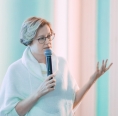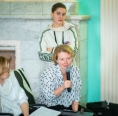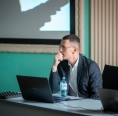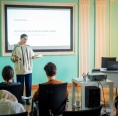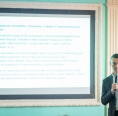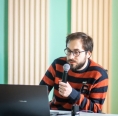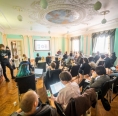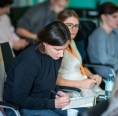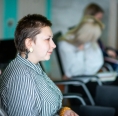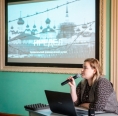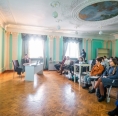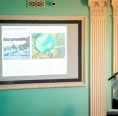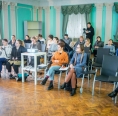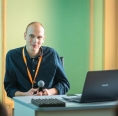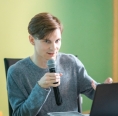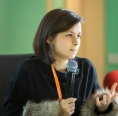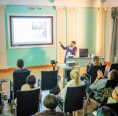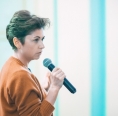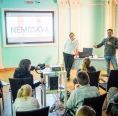-
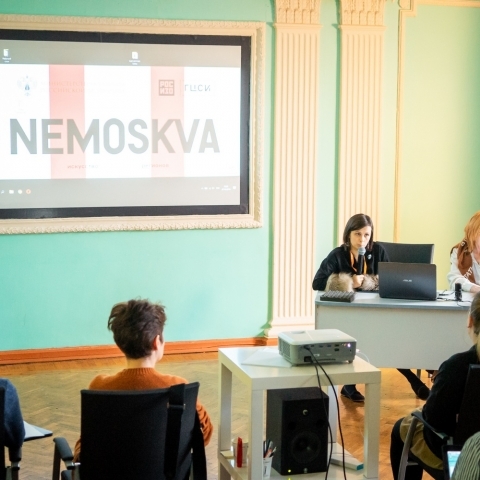
NEW ART PROJECT SCHOOL
NEMOSKVA curatorial school concluded with presentation of projects the participants were working on for two weeks together with the experts.
20 young specialists from Arkhangelsk, Samara, Vladikavkaz, Irkutsk, Kirov, Rostov-on-Don, Chelyabinsk and other cities presented their ideas of future regional curatorial exhibitions to the expert jury. It consisted of NEMOSKVA team members: Alisa Prudnikova, Maria Kalinina, Larisa Grinberg, Anastasia Lomonosova, Antonio Geusa, as well as artist Olga Kiselyova and ambassadors of the project’s partners – Sobranie Fund and SIBUR Holding.
Project formats submitted by the first School graduates vary from exhibits and installations to art-residencies that keep cultural heritage buildings from demolition. Subjects are various, too – some are interested in mythology and local stories of their country, others explore mysteries of the town of Kitezh and Lake Svetloyar, there are also those who are into re-emigrant stories. A thin matter of phlogiston, a glimmer of art, parallels between contemporaries and Alexander Grin’s autobiography, the legacy of the Soviet mosaic – these are just few of the topics that young people bring up in their artistic ideas.
- The minute I saw the information about the school in social media I knew it was a chance for me as a young curator. And when I found out that the school will take place in Satka and that I passed competitive admissions, I was overjoyed indeed. I’m one of those people who love Satka, - Lukia Murina, an artist from Tomsk who visited our city multiple times with her art projects, says. - Due to the fact that the majority of the program consisted of lectures and seminars I did not get enough time to practice on our projects. There was very little time for consultations. But the experience shared with us by Dieter Roelstraete, who is a curator of Documenta 14 and lecturer at the University of Chicago, was extremely useful, he talked about creating exhibits, concept building, placing objects within a space so that they have a bigger conceptual connection and so on.
But the most important result is a project presented by Lukia that was created during the School classes.
- An initial idea I headed there with was very abstract, focused on local Tomsk artists. It remained but gained a form and content. I created the concept of “Taiga Triennale”, with cartography as its topic (a map as a form, the territory of Siberia). Broadly defined artists will participate, the ones working with various modern media. And if I don’t make it to the winners’ list, I will still keep working on this project, I will look for ways to make it happen, it requires a good financial support so I will probably study the grant system.
A lot of projects went through changes during the studying. And even during the final presentation they received new pieces of advice and recommendations. The process is still going on, even today: the participants polish up their ideas. Evaluation of the final versions will be held in the beginning of November. The experts will choose works of three winners that will receive support and will be recommended for execution in the regions of Russia.
And there is a good reason why NEMOSKVA Project Commissioner, ROSIZO – National Centre for Contemporary Art regional Development Director, Ural Industrial Biennale of Contemporary Art Commissioner and Art Director Alisa Prudnikova compared the School to a great experiment. And Antonio Geusa, the Head of the Research and Methodological Department of NCCA, Ph. D., curator, critic, lecturer and teacher, Russia’s leading expert in new technology art even called the event a reality-show. He also pointed out a crucial part of a curator’s job:
- It’s not just about communication and discussion, our job is also about patience and an ability to suffer. The Russian soul knows it well, - Antonio said and added. - Here is a little piece of advice from me: when you put the finishing touches on your projects, make sure you study the history of art. You are developing what has been done before us, and it’s not just about the history of a place and connection with a document, it’s also about studying the history, which is a part of your job. Congratulations to all of you for making it to the finish line. Great job!
While drawing conclusions to a day that was difficult, important, interesting and joyful for all students, Alisa Prudnikova thanked the host side party, partners and the projects team.
- As I was listening to you today, I caught myself thinking: a lucky thing we traveled along the Trans-Siberian Railroad when we started this project. We made it certain for us that there were no empty places, there were communities everywhere, and so were very own situations, special locations that were attractive for diving into and exploring. We hope that thanks to this School you acquired boldness and desire to develop yourself on your own new level with new bonds and ideas. We say it all the time that NEMOSKVA is a work in progress. And it is important for us to hear your feedback: which other formats of classes and interaction you would like to get, how else our institution can serve you. It’s about looking for a conversation. We will try our best to support you, provide you with new opportunities for realization of your ideas I’m sure you have many of them. Thank you very much!
Here’s an opinion:
Anna Legotina, a curator, employee of “OkNo” Chelyabinsk Gallery of Contemporary Art, participant of the Curatorial School, author of project “Artifact. The Glimmer” for art residency “Datcha Ryabushinskikh”:
- I heard about Satka a long time ago, but it’s my first time here. It’s a city with an unbelievably active movement for anesthetization of space. And this process is of high quality, while the results are not only good-looking, they also change people’s lives. This is very impressive. Magnezit Cultural Centre where we spent past two weeks and the industrial vibe surrounding you – it’s overwhelming, and you can’t stop looking trying to absorb the beauty of it! An opportunity to see how large it can be. And all of it is a human creation! That is inspiring indeed!
I have been working as a curator for 10 years and my expectation of the school was that it will bring a professional community together where you can interact and learn. It did happen. Masha Kalinina and Larisa Grinberg contributed a lot to it, coordinating us conceptually. Interaction with the guys is precious – we developed professional relationships, and there were arguments, too. Which is also valuable. We keep in touch (thanks to social media!), it’s nice that the lecturers engage with us actively, they befriend you, they are open for a further discussion. Most certainly, I would like to see the majority of projects presented by my colleagues come to life. I like stories about Mitenkov’s House, pictorial review of UPI (Ural Polytechnic Institute), “Tayozhnaya Triennale” is attractive because of a format and this mapping thing, the women’s education topic is interesting, too, along with others.
Oksana Fodina, Program Director at Potanin’s Fund:
- This is the first example of such a large-scale program in Russia, which, being based on many years of expertise of the National Centre for Contemporary Art, aims at exploration of local cultural experience of particular cities and regions of Russia as well as creates educational programs for development of professional competence among young curators. We believe that this new generation of specialists in the field of contemporary art will be able to present the cultural potential of the Russian regions, put it into a global context, make it visible for ourselves and for the worldwide community.
The NEMOSKVA project has been initiated in 2017 as a strategical project of the modern culture development in the Russian regions from 2018 to 2022. The goal is to develop horizontal communications, promote regional artists and curators, analyze modern situation in places through a professional dialogue, create new opportunities for international partnership.
The main challenge of Curatorial school is discovering and preparation of curators for executing exhibit projects in the regions of the Russian Federation and improvement of curators’ competence for further projects in Russia and abroad.
Strategic partner of the project is Vladimir Potanin’s Charity Fund. Official sponsor is SIBUR. Co-organizer of the Curatorial School is Magnezit Group.
Photo by Denis Shakirov.
Source: Magnezitovets.
-
26.08 - 26.08
DIARY OF THE THIRD INDUSTRIAL BIENNALE
-
28.11 - 28.11
MY SATKA FESTIVAL WINS THE CONTEST OF CORPORATE VOLUNTEER PROJECTS
-
13.10 - 15.10
COOPERATION WITH VGIBL NAMED AFTER M.I. RUDOMINO

